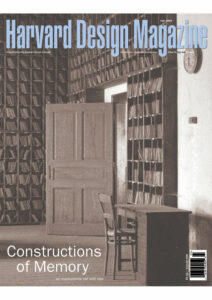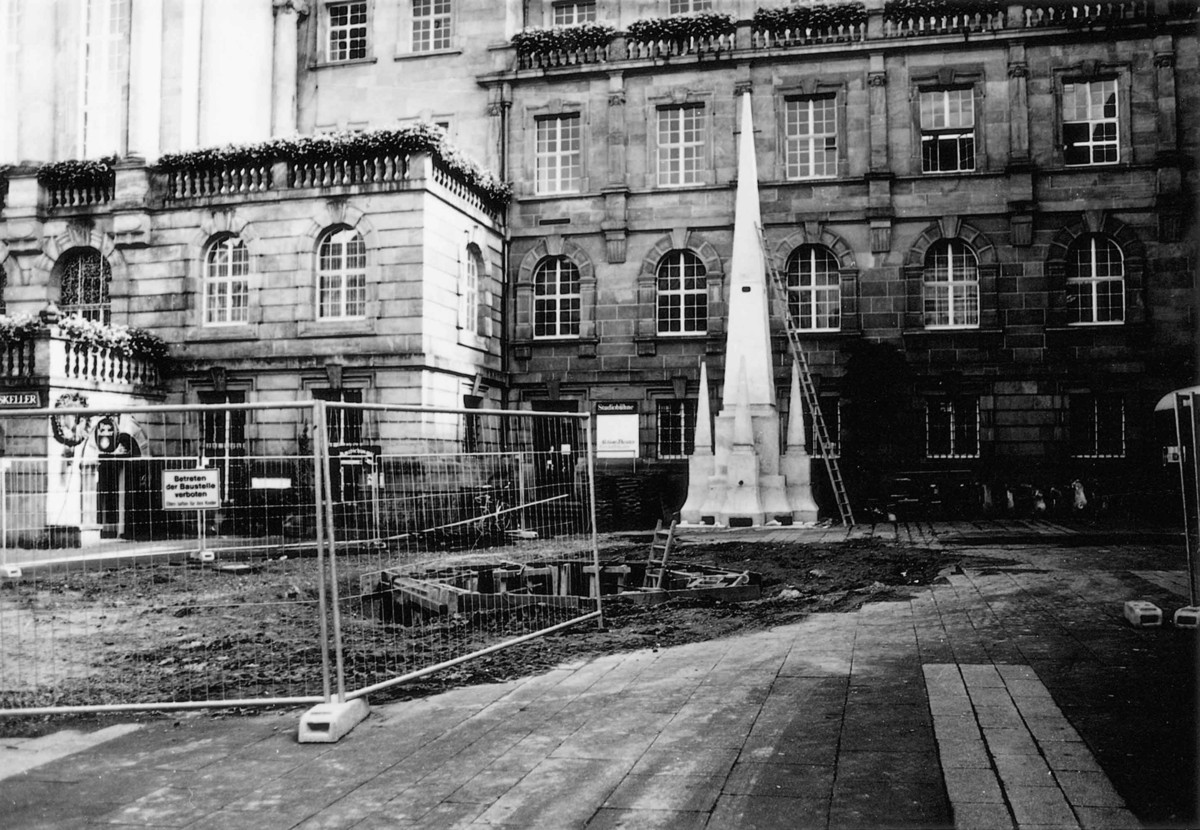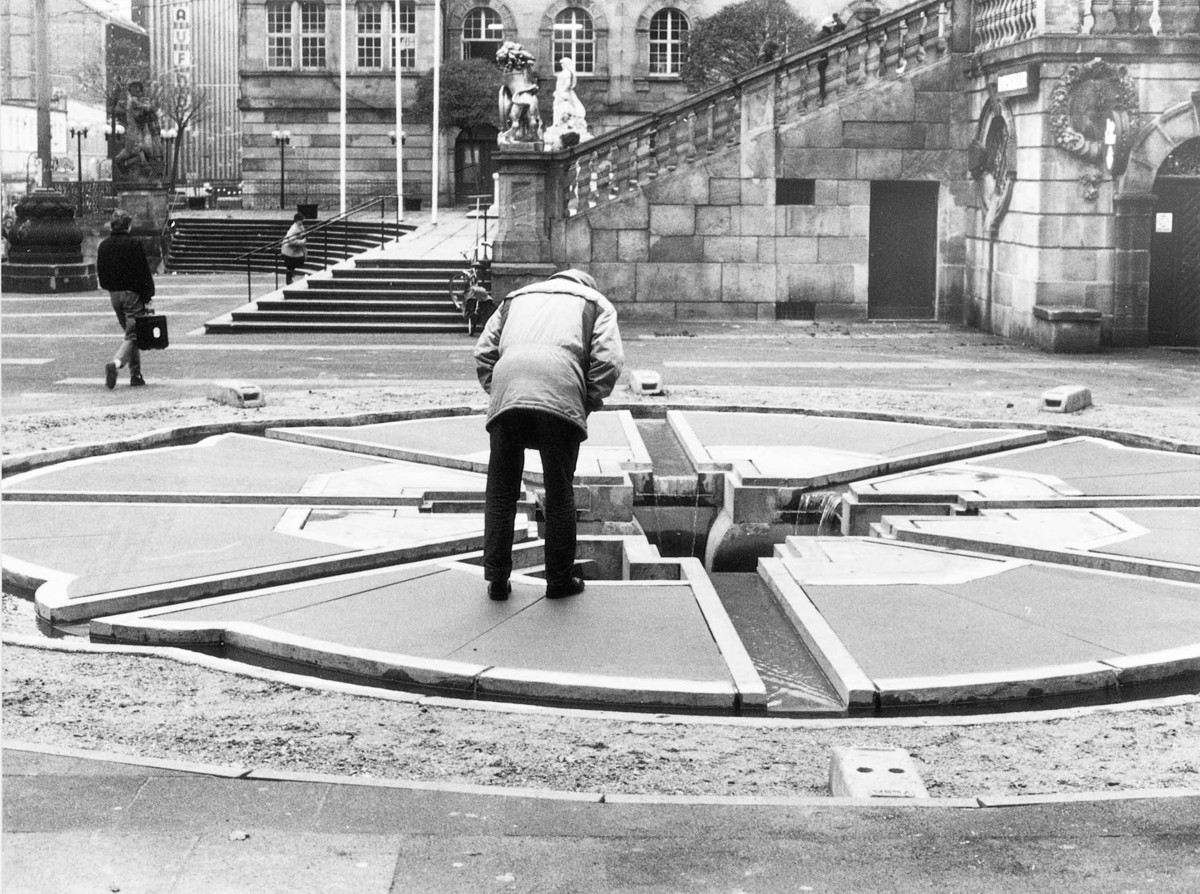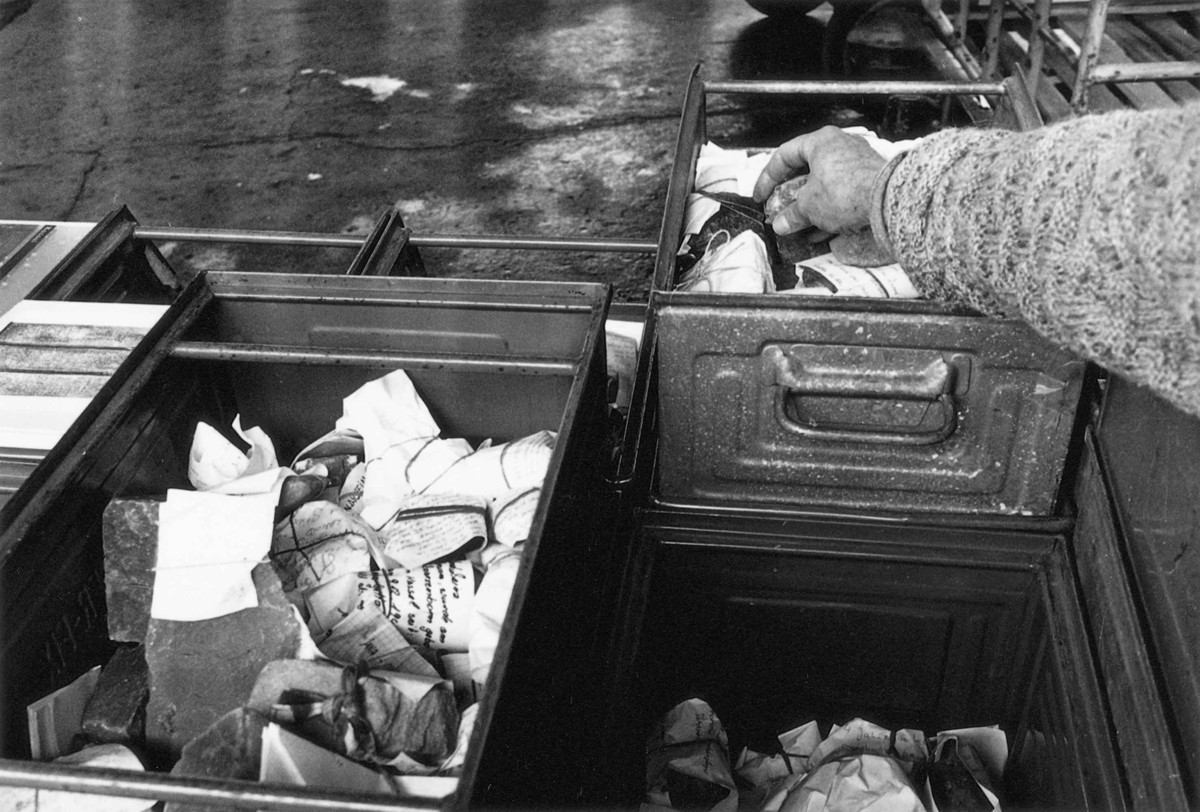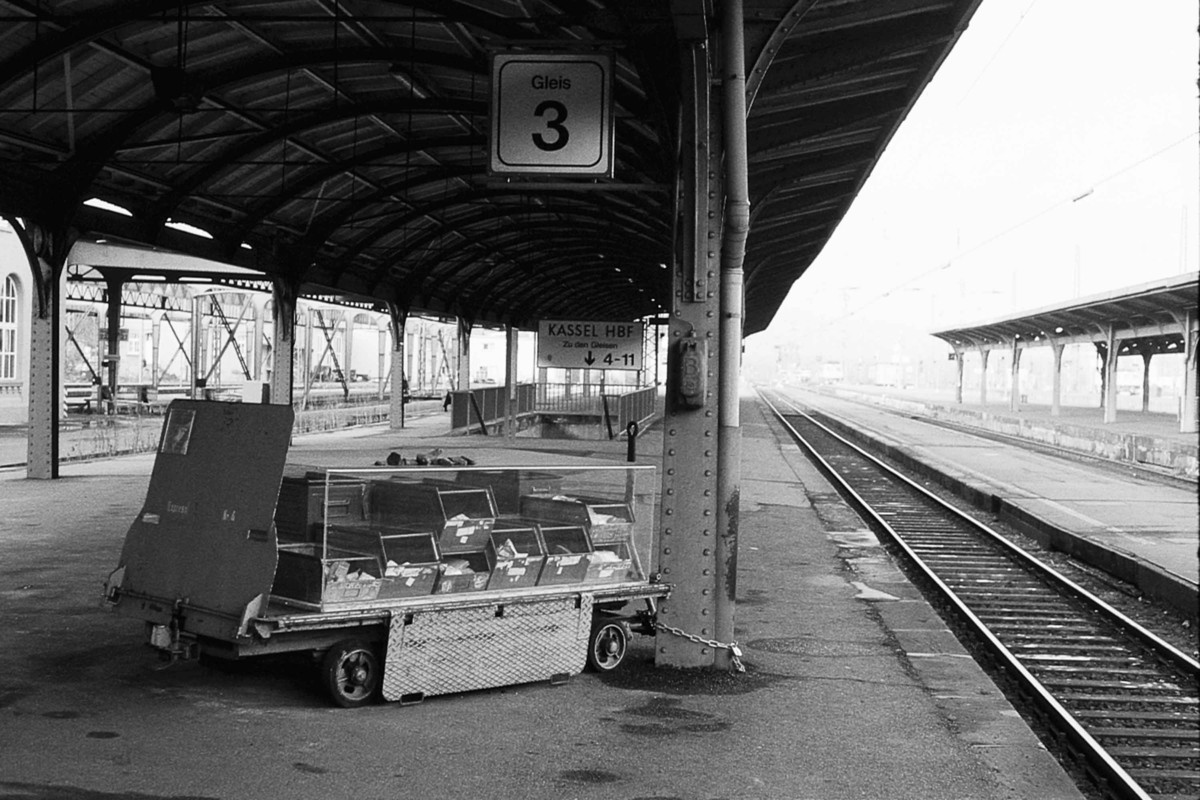Memory and Counter-Memory
Among the hundreds of submissions in the 1995 competition for a German national “memorial to the murdered Jews of Europe,” one seemed an especially uncanny embodiment of the impossible questions at the heart of Germany’s memorial process. Artist Horst Hoheisel, already well known for his negative-form monument in Kassel, proposed a simple, if provocative anti-solution to the memorial competition: blow up the Brandenburg Gate, grind its stone into dust, sprinkle the remains over its former site, and then cover the entire memorial area with granite plates. How better to remember a destroyed people than by a destroyed monument?
Rather than commemorating the destruction of a people with the construction of yet another edifice, Hoheisel would mark one destruction with another destruction. Rather than filling in the void left by a murdered people with a positive form, the artist would carve out an empty space in Berlin by which to recall a now-absent people. Rather than concretizing and thereby displacing the memory of Europe’s murdered Jews, the artist would open a place in the landscape to be filled with the memory of those who come to remember Europe’s murdered Jews. A landmark celebrating Prussian might and crowned by a chariot-borne Quadriga, the Roman goddess of peace, would be demolished to make room for the memory of Jewish victims of German might and peacelessness. In fact, perhaps no single emblem better represents the conflicted, self-abnegating motives for memory in Germany today than the vanishing monument.2
Of course, such a memorial undoing will never be sanctioned by the German government, and this, too, is part of the artist’s point. Hoheisel’s proposed destruction of the Brandenburger Tor participates in the competition for a national Holocaust memorial, even as its radicalism precludes the possibility of its execution. At least part of its polemic, therefore, is directed against actually building any winning design, against ever finishing the monument at all. Here he seems to suggest that the surest engagement with Holocaust memory in Germany may actually lie in its perpetual irresolution, that only an unfinished memorial process can guarantee the life of memory. For it may be the finished monument that completes memory itself, puts a cap on memory work, and draws a bottom line underneath an era that must always haunt Germany. Better a thousand years of Holocaust memorial competitions in Germany than any single “final solution” to Germany’s memorial problem.3
Like other cultural and aesthetic forms in Europe and America, the monument—in both idea and practice—has undergone a radical transformation over the course of the 20th century. As intersection between public art and political memory, the monument has necessarily reflected the aesthetic and political revolutions, as well as the wider crises of representation, following all of this century’s major upheavals—including both the First and Second World Wars, the Vietnam War, and the rise and fall of communist regimes in the former Soviet Union and its Eastern European satellites. In every case, the monument reflects both its sociohistorical and aesthetic context: artists working in eras of cubism, expressionism, socialist realism, earthworks, minimalism, or conceptual art remain answerable to the needs of both art and official history. The result has been a metamorphosis of the monument from the heroic, self-aggrandizing figurative icons of the late 19th century, which celebrated national ideals and triumphs, to the antiheroic, often ironic and self-effacing conceptual installations that mark the national ambivalence and uncertainty of late 20th-century postmodernism.
In fact, the monument as both institution and concept had already come under withering attack well before the turn of the century. “Away with the monuments!” Nietzsche declared in his blistering attack on a 19th-century German historicism that oppressed the living with stultified versions of the past, what Nietzsche called “monumental history.”4 To which critique a chorus of artists and cultural historians have since added their voices. “The notion of a modern monument is veritably a contradiction in terms,” Lewis Mumford wrote in the 1930s. “If it is a monument it is not modern, and if it is modern, it cannot be a monument.”5 Believing that modern architecture invites the perpetuation of life itself, encourages renewal and change, and scorns the illusion of permanence, Mumford wrote, “Stone gives a false sense of continuity, a deceptive assurance of life.”6 Indeed, Mumford went on to suggest that, traditionally, it seems to have been the least effectual of regimes that chose to compensate for their paucity of achievement in self-aggrandizing stone and mortar.
More recently, the late German historian Martin Broszat has suggested that in their references to history, monuments may not remember events so much as bury them altogether beneath layers of national myths and explanations. As cultural reifications, in this view, monuments reduce or, in Broszat’s words, “coarsen” historical understanding as much as they generate it.7 In another vein, art historian Rosalind Krauss finds that the modernist period produces monuments unable to refer to anything beyond themselves as pure marker or base. After Krauss, critics have asked whether an abstract, self-referential monument can ever commemorate events outside of itself, or whether it only motions endlessly to its own gesture to the past, a commemoration of its essence as dislocated sign.8
Still others have argued that rather than preserving public memory, the monument displaces it altogether, supplanting a community’s memory work with its own material form. “The less memory is experienced from the inside,” Pierre Nora warns, “the more it exists through its exterior scaffolding and outward signs.”9 In fact, Andreas Huyssen has even suggested that in a contemporary age of mass memory production and consumption, there seems to be an inverse proportion between the memorialization of the past and its contemplation and study.10
It is as if once we assign monumental form to memory, we have to some degree divested ourselves of the obligation to remember. In the eyes of modern critics and artists, the traditional monument’s essential stiffness and grandiose pretensions to permanence thus doom it to an archaic, premodern status. Even worse, by insisting that its meaning is as fixed as its place in the landscape, the monument seems oblivious to the essential mutability in all cultural artifacts, the ways the significance in all art evolves over time. In this way, monuments have long sought to provide a naturalizing locus for memory, in which a state’s triumphs and martyrs, its ideals and founding myths, are cast as naturally true as the landscape in which they stand. These are the monument’s sustaining illusions, the principles of its seeming longevity and power. But in fact, as several generations of artists—modern and postmodern alike—have made scathingly clear, neither the monument nor its meaning is really everlasting. Both a monument and its significance are constructed in particular times and places, contingent on the political, historical, and aesthetic realities of the moment.
The early modernist ambivalence toward the monument hardened into outright hostility in the wake of the First World War. Both artists and some governments shared a general distaste for the ways the monument seemed formally to recapitulate the archaic valües of a past world now discredited by the slaughter of the war. A new generation of cubists and expressionists, in particular, rejected traditional mimetic and heroic evocations of events, contending that any such remembrance would elevate and mythologize events. In their view, yet another classically-proportioned Prometheus would have falsely glorified and thereby redeemed the horrible suffering they were called upon to mourn. The traditional aim of war monuments had been to valorize the suffering in such a way as to justify it, even redeem it historically. But for these artists, such monuments would have been tantamount to betraying not only their experience of the Great War, but also the new reasons for art’s existence after the war: to challenge the world’s realities, not affirm them.
As Albert Elsen has noted, modern and avant-garde sculptors between the wars in Europe were thus rarely invited to commemorate either the victories or losses, battles or war dead of the First World War.11 And if figurative statuary were demanded of them, then only antiheroic figures would do, as exemplified in the pathetic heroes of Wilhelm Lehmbrück’s Fallen Man and Seated Youth (1917). As true to the artists’ interwar vision as such work may have been, however, neither public nor state seemed ready to abide memorial edifices built on foundations of doubt instead of valor. The pathetic hero was thus condemned by emerging totalitarian regimes in Germany and Russia as defeatist for seeming to embody all that was worth forgetting—not remembering—in the war. Moreover, between the Nazi abhorrence of abstract art—or what it called entartete Kunst, or decadent art—and the officially mandated socialist realism of the Soviet Union, the traditional figurative monument even enjoyed something of a rebirth in totalitarian societies. Indeed, only the figurative statuary of officially sanctioned artists, like Germany’s Arno Breker, or styles like the Soviet Union’s socialist realism, could be trusted to embody the Nazi ideals of “Aryan race” or the Communist Party’s vision of a heroic proletariat. In its consort with two of this century’s most egregiously totalitarian regimes, the monument’s credibility as public art was thus eroded further still.
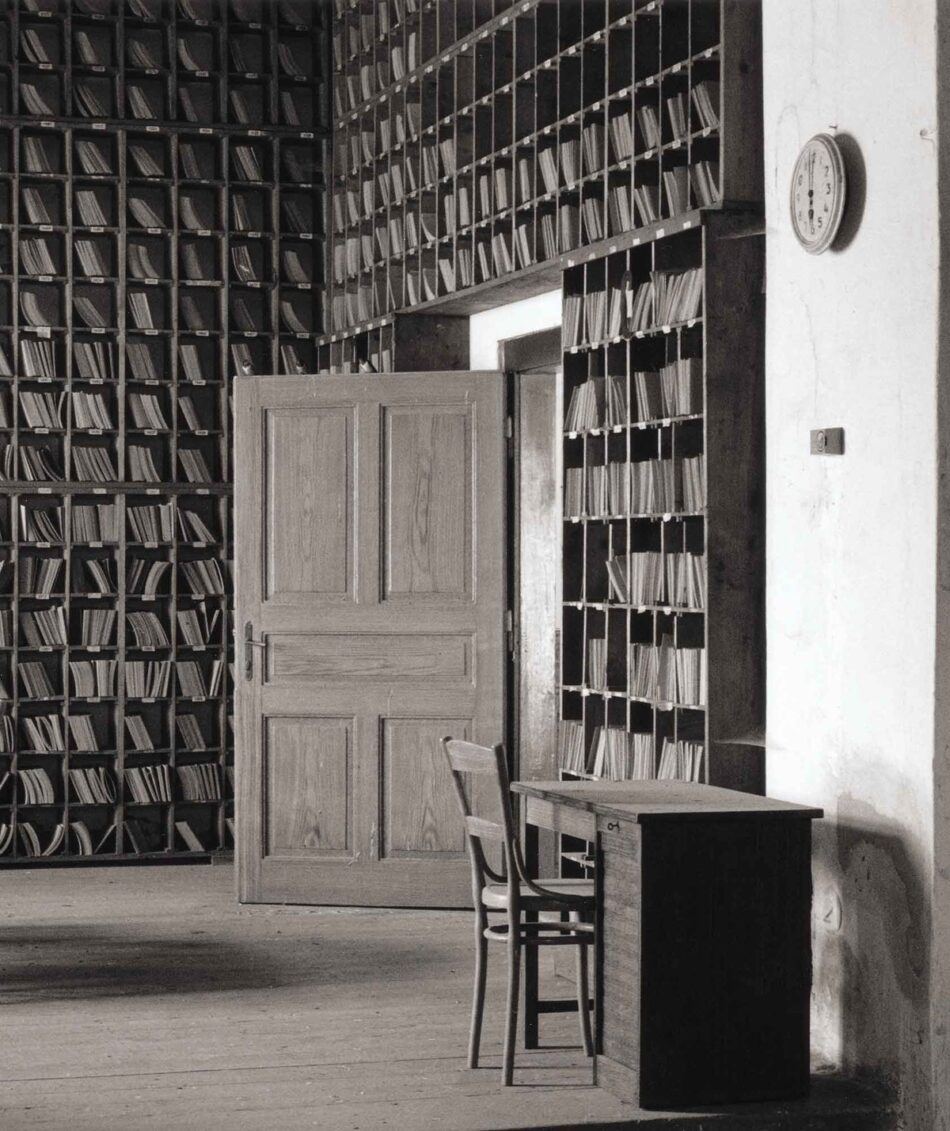
Half a century after the defeat of the Third Reich, contemporary artists in Germany still have difficulty separating the monument there from its fascist past. German memory-artists are heirs to a double-edged postwar legacy: a deep distrust of monumental forms in light of their systematic exploitation by the Nazis, and a profound desire to distinguish, through memory, their generation from that of the killers.12 In their eyes, the didactic logic of monuments—their demagogical rigidity and certainty of history—continues to recall too closely traits associated with fascism itself. How else would totalitarian regimes commemorate themselves except through totalitarian art like the monument? Conversely, how better to celebrate the fall of totalitarian regimes than by celebrating the fall of their monuments? A monument against fascism, therefore, would have to be a monument against itself: against the traditionally didactic function of monuments, against their tendency to displace the past they would have us contemplate—and finally, against the authoritarian propensity in monumental spaces that reduces viewers to passive spectators.
One of the most intriguing results of Germany’s memorial conundrum has been the advent of what I would call its “counter-monuments”: memorial spaces conceived to challenge the very premise of the monument. For a new generation of German artists, the possibility that memory of events so grave might be reduced to exhibitions of public craftsmanship or cheap pathos remains intolerable. They contemptuously reject the traditional forms and reasons for public memorial art, those spaces that either console viewers or redeem tragic events, or indulge in a facile kind of Wiedergutmachung, or reparation, that would purport to mend the memory of a murdered people. Instead of searing memory into public consciousness, conventional memorials, they fear, seal memory off from awareness altogether; instead of embodying memory, such memorials may only displace memory. These artists fear rightly that to the extent that we encourage monuments to do our memory work for us, we become that much more forgetful. They believe, in effect, that the initial impulse to memorialize events like the Holocaust may actually spring from an opposite and equal desire to forget them.
In the pages that follow, I would like to recall a couple of the counter-monuments I have explored previously and to add several more recent installations to the discussion. In doing so I hope to refine and adumbrate the concept of the counter-monument in Germany, the ways they have begun to constitute something akin to a “national form” that pits itself squarely against recent attempts to build a national memorial to the “murdered Jews of Europe” in the center of the country’s reunited capital, Berlin. For I find that the ongoing debate in Germany has been especially instructive in my own considerations of the monument’s future in this decidedly antiredemptory age.
Horst Hoheisel: Negative Forms and Memorial Spielerei
Some ten years before Horst Hoheisel’s proposal to blow up the Brandenburg Gate in Berlin, the city of Kassel had invited artists to consider ways to rescue one of its own destroyed monuments—the “Aschrott Brunnen.” Originally this had been a twelve-meter-high, neo-Gothic pyramidal fountain, surrounded by a reflecting pool set in the main town square, in front of City Hall. Built in 1908, it was designed by the City Hall architect, Karl Roth, and funded by a Jewish entrepreneur from Kassel, Sigmund Aschrott. But as a gift from a Jew to the city, it was condemned by the Nazis as the “Jews’ Fountain” and so demolished by local Nazis during the night of April 8, 1939, its pieces carted away by city work crews over the next few days. Within weeks, all but the sandstone base had been cleared away, leaving only a great, empty basin in the center of the square. Two years later, the first transport of 463 Kassel Jews departed from the Hauptbahnhof to Riga, followed in the next year by another 3,000, all murdered. In 1943, the city filled in the fountain’s basin with soil and planted it over in flowers; local burghers then dubbed it “Aschrott’s Grave.”
During the growing prosperity of the 1960s, the town turned Aschrott’s Grave back into a fountain, sans pyramid. But by then, only a few of the city’s old-timers could recall that its name had ever been Aschrott’s anything. When asked what had happened to the original fountain, they replied that to their best recollection, it had been destroyed by English bombers during the war. In response to this kind of fading memory, the “Society for the Rescue of Historical Monuments” proposed in 1984 that some form of the fountain and its history be restored—and that it recall all the founders of the city, especially Sigmund Aschrott.
In his proposal for “restoration,” Horst Hoheisel decided that neither a preservation of its remnants nor its mere reconstruction would do. For Hoheisel, even the fragment was a decorative lie, suggesting itself as the remnant of a destruction no one knew very much about. Its pure reconstruction would have been no less offensive: not only would self-congratulatory overtones of Wiedergutmachung betray an irreparable violence, but the artist feared that a reconstructed fountain would only encourage the public to forget what had happened to the original. In the best tradition of the counter-monument, therefore, Hoheisel proposed a “negative-form” monument to mark what had once been the Aschrott Fountain in Kassel’s City Hall Square. On being awarded the project, Hoheisel described both the concept and form underlying his negative-form monument:
I have designed the new fountain as a mirror image of the old one, sunk beneath the old place in order to rescue the history of this place as a wound and as an open question, to penetrate the consciousness of the Kassel citizens so that such things never happen again.
That’s why I rebuilt the fountain sculpture as a hollow concrete form after the old plans and for a few weeks displayed it as a resurrected shape at City Hall Square before sinking it, mirror-like, twelve meters deep into the ground water.
The pyramid will be turned into a funnel into whose darkness water runs down. From the “architektonischen Spielerei,” as City Hall architect Karl Roth called his fountain, a hole emerges which deep down in the water creates an image reflecting back the entire shape of the fountain.13
How does one remember an absence? In this case, by reproducing it. Quite literally, the negative space of the absent monument would now constitute its phantom shape in the ground. The very absence of the monument will now be preserved in its precisely duýlicated negative space. In this way, the monument’s reconstruction remains as illusory as memory itself, a reflection on dark waters, a phantasmagoric play of light and image. Taken a step further, Hoheisel’s inverted pyramid might also combine with the remembered shape of its predecessor to form the two interlocking triangles of the Jewish star—present only in the memory of its absence.
In his conceptual formulations, Hoheisel invokes the play of other, darker associations as well, linking the monument to both the town’s Jewish past and a traditional anti-Semitic libel. “The tip of the sculpture points like a thorn down into the water,” the artist writes. “Through coming into touch with the ground water, the history of the Aschrott Fountain continues not over but under the city.” As an emblem of the Holocaust, the history of the Aschrott Fountain becomes the subterranean history of the city. In Hoheisel’s figure, the groundwater of German history may well be poisoned—not by the Jews, but by the Germans themselves in their murder of the Jews. By sinking his inverted pyramid into the depths in this way, Hoheisel means to tap this very history. “From the depth of the place,” he says, “I have attempted to bring the history of the Aschrott Fountain back up to the surface.”
Of course, on a visit to City Hall Square in Kassel, none of this is immediately evident. During construction, before being lowered upside down into the ground, the starkly white negative-form sat upright in the square, a ghostly reminder of the original, now-absent monument. Where there had been an almost forgotten fountain, there is now a bronze tablet with the fountain’s image and an inscription detailing what had been there and why it was lost. As we enter the square, we watch as water fills narrow canals at our feet before rushing into a great underground hollow, which grows louder and louder until we finally stand over the “Aschrott Brunnen.” Only the sound of gushing water suggests the depth of an otherwise invisible memorial, an inverted palimpsest that demands the visitor’s reflection. Through an iron grate and thick glass windows, we peer into the depths. “With the running water,” Hoheisel suggests, “our thoughts can be drawn into the depths of history, and there perhaps we will encounter feelings of loss, of a disturbed place, of lost form.”
In fact, as the only standing figures on this flat square, our thoughts rooted in the rushing fountain beneath our feet, we realize that we have become the memorial. “The sunken fountain is not the memorial at all,” Hoheisel says. “It is only history turned into a pedestal, an invitation to passersby who stand upon it to search for the memorial in their own heads. For only there is the memorial to be found.” Hoheisel has left nothing but the visitors themselves standing in remembrance, left to look inward for memory.
Christian Boltanski, Micha Ullman, Rachel Whiteread
On a walk through Berlin’s former Jewish Quarter, curiousity drew Christian Boltanski to the occasional gaps and vacant lots between buildings. On inquiring, he found that the building at Grosse Hamburgerstrasse 15-16 had been destroyed by Allied bombings in 1945 and was never rebuilt. In a project he mounted for a 1990 exhibition,Die Endlichkeit der Freiheit, called “Missing House,” the artist thus set to work retracing all the lives of people who had lived in this vanished house between 1930 and 1945—both the Jewish Germans who had been deported and the non-Jewish Germans who had been given their homes.14
He found family photographs, letters, children’s drawings, rationing tickets, and other fragments of these lives, and photocopied them and put them together with maps of the neighborhood in archival boxes. At this point, he had name plates hung on the white plastered wall of the building next door to identify the now missing inhabitants, Jews and non-Jews—leaving the lot empty. His “Missing House” project thus became emblematic for Boltanski of the missing Jews who had once inhabited it; as its void invited him to fill it with memory, he hoped it would incite others to remember as well.
In two other installations, only one realized as yet, artists Micha Ullman and Rachel Whiteread have also turned to both bookish themes and negative spaces to represent the void left behind by the “people of the book.” To commemorate the infamous Nazi book burning of May 10, 1933, the City of Berlin invited Micha Ullman, an Israeli-born conceptual and installation artist, to design a monument for the Bebelplatz, just off the Unter den Linden. Today, the cobblestone expanse of this plaza is still empty of all forms except for the figures of visitors who stand there and peer down through a window in the ground plane into the ghostly white, underground room of empty shelves Ullman has installed. A steel tablet set into the stones simply recalls that this was the site of some of the most notorious book burnings and quotes Heinrich Heine’s famously prescient words: “Where books are burned, so one day will people be burned as well.” But the shelves are still empty, unreplenished, and it is the absence of both people and books that is marked here in yet one more empty memorial pocket.
Renata Stih and Frieder Schnock
To the Berlin artists Renata Stih and Frieder Schnock, their city is haunted by its own deceitful beauty, its most placid and charming neighborhoods seemingly oblivious and indifferent to the all-too-orderly destruction of their Jewish community during the war. Tree-lined and with its 19th-century buildings relatively unscathed by Allied bombs, the Bayerische Viertel, or Bavarian Quarter, of Berlin’s Schoenberg district is particularly peaceful these days, off the tourist track. Before the war it had been home to some 16,000 German Jews, many of them professional and well-to-do, including at different times Albert Einstein and Hannah Arendt. But with nary a sign of the war’s destruction in evidence, nothing in the neighborhood pointed to the absence of its escaped, deported, and murdered Jewish denizens.
Haunted precisely by this absence of signs, and skeptical of the traditional memorial’s tendency to concentrate what they thought should be pervasive memory into a single spot, Renata Stih and Frieder Schnock won a 1993 competition for a memorial to the neighborhood’s murdered Jews with a proposal to mount eighty signposts on the corners, streets, and sidewalks in and around the Bayerische Platz. Each would include a simple image of an everyday object on one side and a short text on the other, excerpted from Germany’s anti-Jewish laws of the 1930s and ’40s. On one side of such a sign, pedestrians would see a hand-drawn sidewalk hopscotch pattern, and on the other its accompanying text: “Arischen und nichtarischen Kindern wird das Spielen miteinander untersagt”—“Aryan and non-Aryan children are not allowed to play together,” from a 1938 law. Or a simple red park bench on a green lawn: “Juden durfen am Bayerischen Platz nur die gelb markierten Sitzbanke benutzen”—“On the Bavarian Place, Jews may sit only on yellow park benches,” from 1939. Or a pair of swim trunks: “Berliner Bademanstalten und Schwimmbader durfen von Juden nicht betreten werden”—“Baths and swimming pools in Berlin are closed to Jews,” from December 3, 1938. Or a black-and-white rotary telepone dial: “Telefonanschlusse von Juden werden von der Post gekundigt”—“Telephone lines to Jewish households will be cut off,” from July 29, 1940.17
With the approval of the Berlin Senate, which had sponsored the memorial competition, the artists put their signs up on light posts throughout the quarter without announcement, provoking a flurry of complaints and calls to the police that neo-Nazis had invaded the neighborhood with anti-Semitic signs. Thus reassured that the public had taken notice, the artists pointed out that these same laws had been posted and announced no less publicly at the time—but had provoked no such response by Germans then. At least part of the artists’ point was that the laws then were no less public than the memory of them now. Indeed, one sign with the image of a file even reminds local residents that “All files dealing with anti-Semitic activities [were] to be destroyed,” from a law of February 16, 1945; and another image of interlocking Olympic rings recalls that “Anti-Semitic signs in Berlin [were] temporarily removed for the 1936 Olympic Games.” That is, for the artists, even the absence of signs was an extension of the crime itself. Stih and Schnock recognize here that the Nazi persecution of the Jews was designed to be, after all, a self-consuming Holocaust, a self-effacing crime.
The only “signs” of Jewish life in this once Jewish neighborhood are now the posted laws that paved the way for the Jews’ deportation and murder. As part of the cityscape, these images and texts would “infiltrate the daily lives of Berliners,” Stih has explained, no less than the publicly posted laws curtailed the daily lives of Jews between 1933 and 1945. And by posting these signs separately, forcing pedestrians to happen upon them one or two at a time, the artists can show how the laws incrementally “removed Jews from the social realm,” from the protection of law. These “places of remembrance” would remind local citizens that the murder of the neighborhood’s Jews did not happen overnight, or in one fell swoop, but over time—and with the tacit acknowledgment of their neighbors. Where past citizens once navigated their lives according to these laws, present citizens would now navigate their lives according to the memory of such laws.
In keeping with their vision of decentralized memory, of integrating memory of the Holocaust into the rhythms of everyday life, Stih and Schnock proposed an audacious “non-monument” for the 1995 international competition for Germany’s national memorial to Europe’s murdered Jews. Taking as their premise the essential impossibility and undesirability of a “final memorial” to commemorate the Nazis’ Final Solution to the Jewish question, they submitted a design called Bus Stop—The Non-Monument. Rather than filling the designated space of nearly 20,000 square meters between the Brandenburg Gate and Potsdamer Platz, they would keep this area desolate as a reminder of the destruction brought upon Berlin by the Nazis and turn it into an open-air bus terminal for coaches departing to and returning from regularly scheduled visits to several dozen concentration camps and other sites of destruction throughout Europe. “There is not one single bus stop in central Berlin from which you can take buses to the places listed in this schedule,” the artists tell us in a foreword to their project’s prècis.18 Therefore they call for a single place where visitors can board a bright red bus at a regularly scheduled hour for a nonstop ride and visit not only well-known sites like Auschwitz, Treblinka, and Dachau, but also the lesser known massacre sites in the east, like Vitebsk and Trawniki. A central steel and glass waiting hall flanking the 130-meter-long boarding platform would provide travelers with computer-generated histories and bibliographies of all the sites listed at the terminal, a kind of memorial travel office that would extol history and memory over the usual forgetfulness, the attempt at amnesia, that drives most leisure vacations. Buses would leave hourly for sites within Berlin and daily for sites outside the city. Not so much a “central memorial” as a “centrifugal” memorial, Bus Stopwould send visitors out in all directions into a Europe-wide matrix of memorial sites.
With twenty-eight buses making local Berlin runs every hour, and another sixty or so branching out daily for sites throughout Germany and elsewhere in Europe, this would also be, quite literally, a mobile memorial that paints its entire matrix of routes with memory. By becoming a part of everyday life in Berlin, these red buses emblazoned with destinations like Buchenwald and Sobibor would, the artists hope, remind everyone of the “thorough integration of the terror machinery [itself] within everyday life in Germay from 1933 to 1945.”19 At night the rows of parked and waiting buses, with their destinations illuminated, become a kind of “light-sculpture” that dissolves at the break of day into a moving mass to reflect what Bernd Nicolai has called “the busy banality of horror.”20
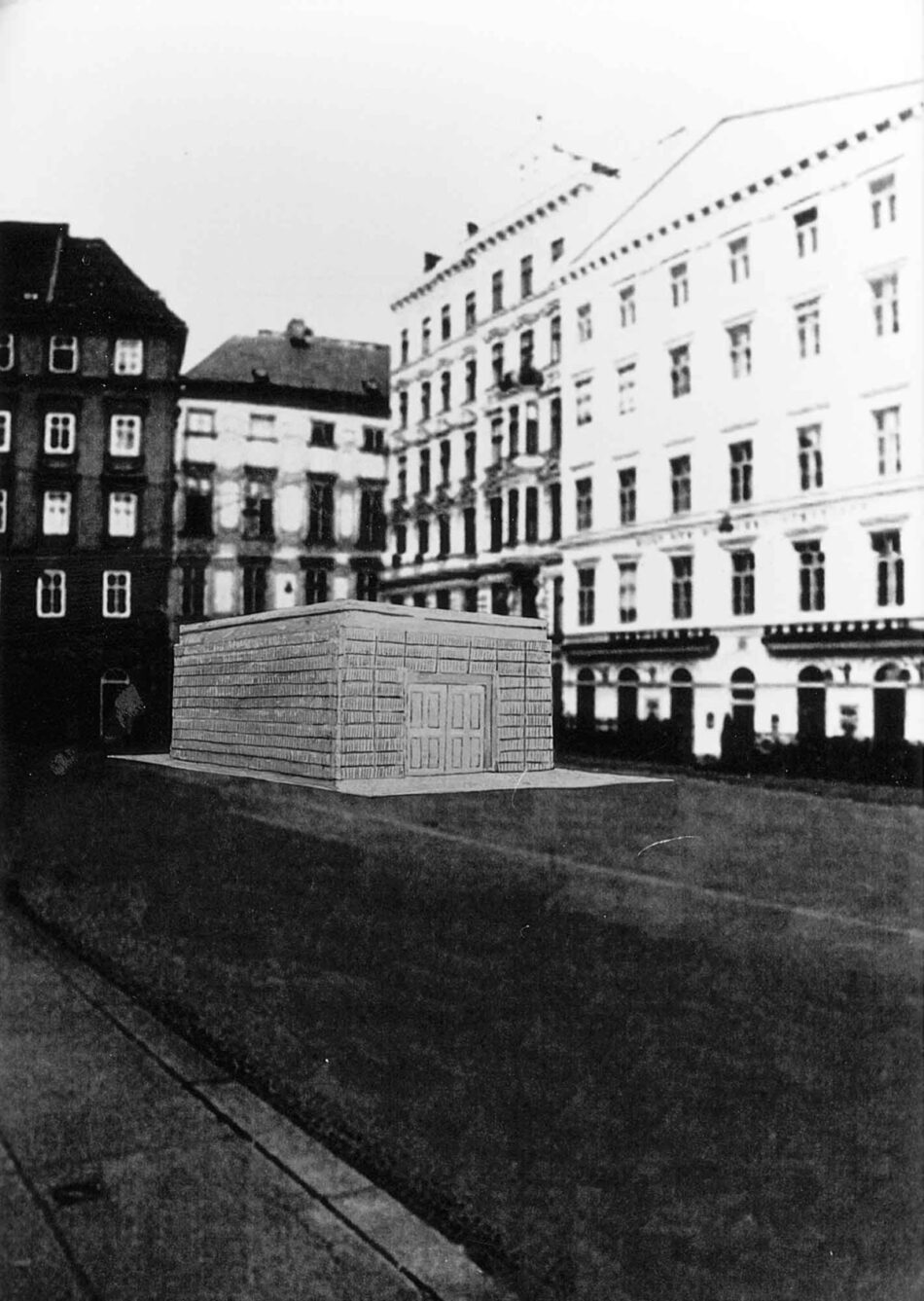
Arguable the most popularly acclaimed of all entries in the competition, Bus Stop placed eleventh among the 528 submissions from around the world. Organizers at the time, however, intent on concentrating memory of Europe’s murdered Jews into a single site in Berlin, felt that Bus Stop dispersed memory too far and wide, implicitly spreading the blame for the murder onto the regimes of nations whose citizens had been themselves conquered during the war. In response, the artists self-published a 128-page “Fahrplan,” or timetable, of actual departure times of buses, trains, and planes in the public transportation sector for all the sites in their original memorial plan. Unlike the conventional timetable, however, Stih and Schnock added concise histories of the sites themselves to accompany the hours of departure and return. The schedule to Lodz, for instance, tells us both how to get thereand how many Jews lived there before the war, how the ghetto there was established, when it was liquidated, how the deported Jews were murdered, and who did the killing. Similar histories accompany schedules to Lublin, Stutthof, Riga, Drancy, Babi Yar, and the other ninety or so destinations, including dozens in Germany alone.
Like other counter-memorials, Bus Stop would, in effect, return the burden of memory to visitors themselves by forcing visitors into an active role. Though the bus rides might recall the deportations themselves, these would be deportations not to actual history but to memory. Indeed, the ride to and from the sites of destruction would constitute the memory-act, thereby reminding visitors that memory can be a kind of transport through space in an ongoing present, as well as a transport through time itself. In this way, the memorial remains a process, not an answer, a place that provides time for memorial reflection, contemplation, and learning between departing and arriving.
For an American watching Gemany’s memorial culture come to terms with the Holocaust, the conceptual torment implied by the counter-monument holds immense appeal. Although provocative and difficult, no other memorial form seems to embody so well both the German memorial dilemma and the limitations of the traditional monument. The most important “space of memory” for these artists has not been that in the ground or above it, but that space between the memorial and viewer, between the viewer and his own memory: the place of the memorial in the viewer’s mind, heart, and conscience. To this end, they have attempted to embody the ambiguity and difficulty of Holocaust memorialization in Germany in conceptual, sculptural, and architectural forms that would return the burden of memory to those who come looking for it. Rather than creating self-contained sites of memory, detached from our daily lives, these artists would force both visitors and local citizens to look within themselves for memory, at their actions and motives for memory within these spaces. In the cases of disappearing, invisible, and other counter-monuments, they have attempted to build into these spaces the capacity for changing memory, places where every new generation will find its own significance in this past.
In the end, the counter-monument reminds us that the best German memorial to the fascist era and its victims may not be a single memorial at all—but simply the never-to-be-resolved debate over which kind of memory to preserve, how to do it, in whose name, and to what end. That is, what are the consequences of such memory? How do Germans respond to current persecutions of foreigners in their midst in light of their memory of the Third Reich and its crimes? Instead of a fixed sculptural or architectural icon for Holocaust memory in Germany, the debate itself—perpetually unresolved amid ever-changing conditions—might now be enshrined.
The status of monuments in the 20th century remains double-edged, fraught with an essential tension: outside of those nations with totalitarian pasts, the public and governmental hunger for traditional, self-aggrandizing monuments is matched only by the contemporary artists’ skepticism of the monument. As a result, even as monuments continue to be commissioned and designed by governments and public agencies eager to assign singular meanings to complicated events and people, artists increasingly plant in them the seeds of self-doubt and impermanence. The state’s need for monuments is acknowledged, even as the traditional forms and functions of monuments are increasingly challenged. Monuments at the end of the 20th century are thus born resisting the very premises of their birth. The monument has increasingly become the site of contested and competing meanings, more likely the site of cultural conflict than of shared national values and ideals.
The End of the Monument in Germany
The sunken fountain is not the memorial at all. It is only history turned into a pedestal, an invitation to passersby who stand upon it to search for the memorial in their own heads. For only there is the memorial to be found.
— Horst Hoheisel1
Neo-Nazi demonstrators protesting an exhibition on the Wehrmacht that came to Kassel in June 1998 were granted permission by the mayor to hold their protest in the Aschrott Brunnen plaza, in front of City Hall. Here they stood atop the original fountain’s foundation stones that had been salvaged by Hoheisel to mark the perimeter of the original fountain. Skinheaded and tattooed, wearing black shirts and fatigues, the neo-Nazis waved black flags and taunted a crowd of counter-protesters who had assembled outside police barricades surrounding the protesters. In a press release, the artist Hoheisel recounted a chronological history of the site: the donation of the fountain to the city of Kassel by Sigmund Aschrott, its demolition at the hands of the Nazis in 1939, the memorial’s dedication in 1987, and finally the neo-Nazi demonstration. For Hoheisel, the neo-Nazis’ “reclamation” of the site, their triumphal striding atop the ruins of the fountain that their forebears had destroyed in 1939, seemed to bear out his dark hope that this would become a negative center of gravity around which all memory—wanted and unwanted—would now congeal.
By this time, Horst Hoheisel had initiated several other memorial projects, including another in Kassel. In 1991 he turned to the next generation with a more pedagogically inclined project. With permission from the local public schools, the artist visited the classrooms of Kassel with a book, a stone, and a piece of paper. The book was a copy of Namen und Schicksale der Juden Kassels (The Names and Fates of Kassel’s Jews). In his classroom visits, Hoheisel would tell students the story of Kassel’s vanished Jews, how they had once thrived there, lived in the very houses where these school children now lived, sat at these same classroom desks. He then asked all the children who knew any Jews to raise their hands. When no hand appeared, Hoheisel would read the story of one of Kassel’s deported Jews from his memory book. At the end of his reading, Hoheisel invited each of the students to research the life of one of Kassel’s deported Jews: where they had lived and how, who were their families, how old they were, what they had looked like. He asked them to visit formerly Jewish neighborhoods and get to know the German neighbors of Kassel’s deported Jews.
After this, students were asked to write short narratives describing the lives and deaths of their subjects, wrap these narratives around cobblestones and deposit them in one of the archival bins the artist had provided every school. After several dozen such classroom visits, the bins had begun to overflow and new ones were furnished. In time, all of these bins were transported to Kassel’s Hauptbahnhof, where they were stacked on the rail platform from where Kassel’s Jews were deported. It is now a permanent installation, what the artist call his Denk-Stein Sammlung, or memorial stone archive.
This memorial cairn—a pile of stones bearing witness—marks the site both of deportation and of the community’s education about its murdered Jews, their absence now marked by the still evolving memorial. Thus combining narrative and stone, the artist and students have adopted the most Jewish of memorial forms as their own—thereby enlarging their memorial lexicon to include that of the absent people they would now recall. After all, only they are now left to write the epitaph of the missing Jews, known and emblematized by their absence, the void they have left behind.
Similarly, when invited by Volkhard Knigge, the director of the Buchenwald Museum, shortly after its postreunification revisions to memorialize the first monument to liberation erected by the camp’s former inmates in April 1945, Hoheisel proposed not a resurrection of the original monument but a “living” alternative. In collaboration with an architect, Andreas Knitz, the artist designed a concrete slab with the names of fifty-one national groups victimized here and engraved with the initials K.L.B., standing for Konzentrationslager Buchenwald, words that had been marked on the prisoners’ original wooden memorial obelisk. And since that obelisk had been constructed out of pieces of barracks torn down by former inmates—that is, given new life by the prisoners’ own hands—Hoheisel built into his concrete memorial slab a radiant heating system set at a constant 98.6 degrees Fahrenheit, to suggest the body heat of those whose memory it would now enshrine. Visitors almost always kneel to touch the slab, something they would not do if it were cold stone, and are touched in turn by the human warmth embodied there. Dedicated in April 1995, on the fiftieth anniversary of the prisoners’ memorial (which lasted only two months), this warm memorial reminds visitors of the memory of actual victims that has preceded their own, subsequent memory of this time. In winter, with snow covering the rest of the ground, this slab is always clear, an all-season marker for the site of the original attempt to commemorate the crimes of Buchenwald.
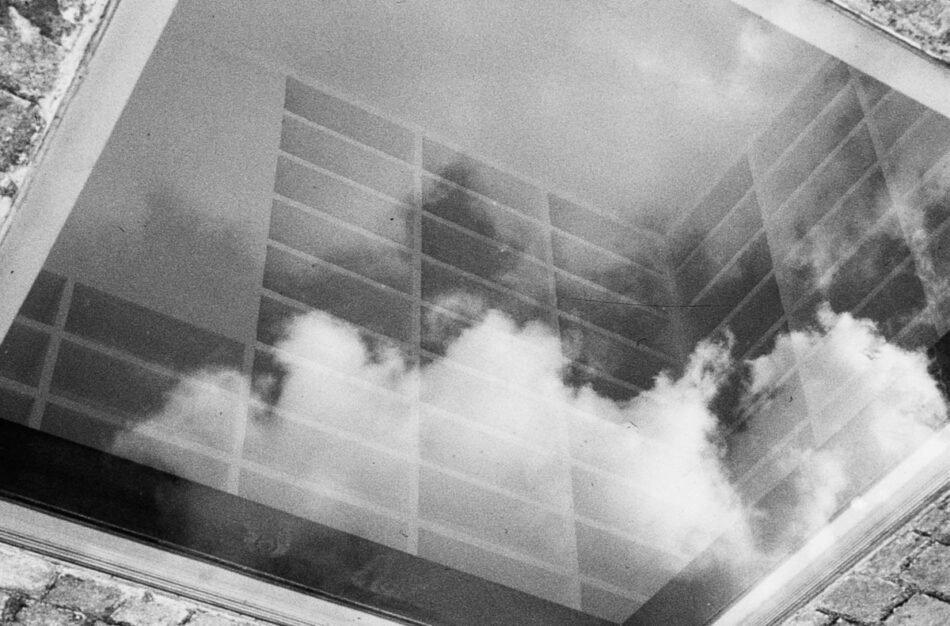
Indeed, the English sculptor Rachel Whiteread has proposed casting the very spaces between and around books as the memorial figure by which Austria’s missing Jews would be recalled in Vienna’s Judenplatz. In a 1996 competition initiated by Nazi hunter Simon Wiesenthal, a distiguished jury of experts appointed by the city chose a brilliant, if abstract and controversial, design by Whiteread. Her proposal for Vienna’s official Holocaust memorial—the positive cast of the space around books in an anonymous library, the interior turned inside-out—thus extends her sculptural predilection for solidifying the spaces over, under, and around everyday objects, even as it makes the book itself her central memorial motif. But even here, it is not the book per se that constitutes her now displaced object of memory, but the literal space between the book and us. For as various observers have noted, Whiteread’s work has made brilliantly palpable the notion that materiality can also be an index of absence: whether it is the ghostly apparition of the filled-in space of a now demolished row house in London or the proposed cast of the empty space between the book leaves and the wall in a full-size library, Whiteread makes the absence of an original object her work’s defining preoccupation.15 Like other artists of her generation, she is preoccupied less with the Holocaust’s images of destruction and more with the terrible void this destruction left behind.
Given this thematic edge in all her work, it is not surprising that Whiteread was one of nine artists and architects invited to submit proposals for the Vienna Holocaust memorial. Other invitees included the Russian installation artist Ilya Kabakov, Israeli architect Zvi Hecker, and American architect Peter Eisenman. As proposed, Whiteread’s cast of a library turned inside-out measures ten by seven meters, is almost four meters high, and resembles a solid white cube. Its outer surface would consist entirely of the roughly textured negative space next to the edges of book leaves. On the front wall facing onto the square would be a double-wing door, also cast inside out and inaccessible. In its formalization of absence, on the one hand, and of books, on the other, it found an enthusiastic reception among a jury looking for a design that “would combine dignity with reserve and spark an aesthetic dialogue with the past in a place that is replete with history.”16 Despite the jury’s unanimous decision to award Whiteread’s design first place and to begin its realization immediately, the aesthetic dialogue it very successfully sparked in this place so “replete with history” eventually paralyzed the entire memorial process.
For like many such sites in Vienna, the Judenplatz was layered with the invisible memory of many anti-Semitic persecutions—a synagogue was torched there in a 1421 pogrom, and hundreds of Jews died in the autos-da-fè that followed. Though Whiteread’s design had left room at the site for a window into the archaeological excavation of this buried past, the shopkeepers on the Judenplatz preferred that these digs into an ancient past also be left to stand for the more recent murder of Austrian Jews as well. And although their anti-Whiteread petition of 2,000 names refers only to the lost parking and potential for lost revenue they fear this “giant colossus” will cause, they may also have feared the loss of their own Christian memory of this past. Indeed, to date, the sole memorial to this medieval massacre can be found in a Catholic mural and inscription on a Baroque facade overlooking the site of the lost synagogue. Alongside an image of Christ being baptized in the River Jordan, an inscription reads, in Latin: “The flame of hate arose in 1421, raged through the entire city, and punished the terrible crimes of the Hebrew dogs.” In the end, the reintroduction into this square of a specifically Jewish narrative may have been just as undesirable for the local Viennese as the loss of parking places.
In fact, unlike Germany’s near obsession with its Nazi past, Austria’s relationship to its wartime history has remained decorously submerged, politely out of sight. Indeed, the postwar identity of Austria had been based (with the tacit encouragement of American and Soviet occupiers) upon the self-serving myth that the country was Hitler’s first victim. That some 50 percent of the Nazi SS was composed of Austrians, or that Hitler himself was Austrian-born, was never denied. But these historical facts have never really found a place in Austria’s carefully constructed postwar persona. In a city that seemed to have little national reason for remembering the murder of its Jews, the entire memorial project was soon engulfed by aesthetic and political Sturm und Drang, and the vociferous arguments against the winning design brought the process to a grinding halt. Maligned and demoralized, Whiteread soon lost stomach for the fight and resigned herself, she told me, to the likelihood that her memorial would never be built.
But then, in early 1998, Viennese officials announced that a compromise had been found that would allow Whiteread’s memorial to be built. By moving the great cube one meter within the plaza itself, the city found that there would be room for both the excavations of the 1421 pogrom and the new memorial to the Jews murdered by the Nazis. Nonetheless, the debate in Austria has remained curiously displaced and sublimated. Lost in the discussion were the words that one of the jurors and a curator at New York’s Museum of Modern Art, Robert Storrs, had used to describe what made Whiteread’s work so appropriate in the first place. “Rather than a tomb or cenotaph,” Storrs wrote, “Whiteread’s work is the solid shape of an intangible absence—of a gap in a nation’s identity, and a hollow at a city’s heart. Using an aesthetic language that speaks simultaneously to tradition and to the future, Whiteread in this way respectfully symbolizes a world whose irrevocable disappearance can never be wholly grasped by those who did not experience it, but whose most lasting monuments are the books written by Austrian Jews before, during and in the aftermath of the catastrophe brought down on them.” Rather than monumentalizing only the moment of destruction itself, Whiteread’s design would recall that which made the “people of the book” a people: their shared relationship to the past through the book. For it was this shared relationship to a remembered past that bound Jews together, and it was the book that provided the site for this relationship.
Though Whiteread is not Jewish, she has—in good Jewish fashion—cast not a human form but a sign of humanity, gesturing silently to the acts of reading, writing, and memory that had once constituted this people as a people. If Vienna has truly chosen to go ahead with Whiteread’s allusive and rigorously intellectual design, then the city and its Jewish community will be the richer for it: the Jewish community for the courage and audacity of its aesthetic convictions, and the city for finally bringing boldly to the surface its previously subterranean shame.
James E. Young is professor of English and Judaic Studies at the University of Massachusetts at Amherst. He is the author of Writing and Rewriting the Holocaust and The Texture of Memory and editor of The Art of Memory. This essay is drawn from his latest book, After-Image: The Uncanny Arts of Holocaust Memory, forthcoming from Yale University Press. It appears here with permission of the publisher.
